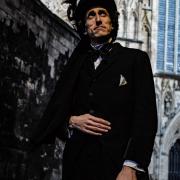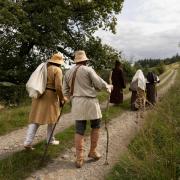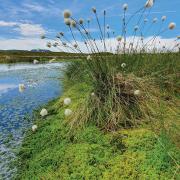The sea cliffs from Filey to Bridlington protect the UK’s largest mainland seabird colony, the only mainland gannetry in England, and the largest mainland black-legged kittiwake colony in the UK; Flamborough Head is one of the most important seabird colonies in Europe for its raucous multitude of spring and summer visitors.
Meet our favourites:

Fulmars
Gull-like in appearance, fulmars are actually related to the albatross. This grey and white seabird nests on rocky cliff edges, and can be distinguished from other seabirds by its preference of flying low over the sea with stiff, shallow wingbeats. In the 1800s, fulmars only nested in one or two places on islands in the far north of Scotland – and have since expanded their range and can be found around the UK's coast. They are most famous – whether positively or not! – for their ability to spit a foul-smelling oily mixture at intruders which apparently smells like rotting fish: ‘fulmar’ actually means ‘foul-gull’ in Old Norse!

Kittiwakes
The kittiwake is our most sea-loving gull, only turning up inland on odd occasions and spending winter out on the Atlantic. Medium-sized, elegant and gentle-looking, kittiwakes eat fish, shrimps and worms, and do not scavenge at landfill sites like other gulls. The kittiwake is easily identifiable from its black wing tips even in flight, which look like they have been dipped in ink, silvery-grey backs and white bellies, and at its clifftop nesting colonies which are large, dense and noisy. This is particularly due to its 'kittiwake' call, which is a shrill 'kittee-wa-aaake, kitte-wa-aaake' and gives the kittiwake its name.

Gannets
Gathering in large numbers over the waves, gannets hover over a shoal of fish, turning and folding their wings, and then plummet head first into the water in search of a meal. Diving from heights of 30m, gannets can hit the water at speeds of up to 60mph!
The size of a goose, the northern gannet is the largest of our seabirds. Bright white with a black-tipped six foot wingspan, they can be identified by their ‘piano-key’ wings; although adult gannets have almost pure white wings, for the first four years of their life gannets’ wings are mottled black, brown and white in bars along the feathers, looking amazingly like piano keys. The UK is home to 55% of the world’s gannet population, and Flamborough Head is one of the largest mainland colonies in the country.

Puffins
A funny little fellow in his glossy black dinner jacket and crisp white bib, puffins are sometimes referred to as ‘sea parrots’ or ‘the clowns of the sea’ because they are instantly recognisable from their brightly coloured, parrot-like bill. They only return to Yorkshire for three to four months each year and have mostly left the cliffs by August.
Spending winter at sea, every year thousands of puffins return to the UK to nest in their little hobbit-like burrows in the ground. Puffins are loyal to one another, each year mating with the same bird and producing one chick. This one chick, known as a puffling, keeps its parents busy though fishing for sand eels to keep it well-fed and satisfied. The bill of a puffin is serrated to hold fish in place; one puffin was recorded as having 83 small sandeels in its bill at once!
How to enjoy Yorkshire’s seabird city
The best way to really experience the sights, sounds and smells of Flamborough Head’s seabird metropolis is from the sea. Running throughout June and July, join a Flamborough Wildlife Cruise in a traditional fishing coble setting sail from North Landing beach to explore the white sea cliffs from below, led by a wildlife guide.
Seabirds can be enjoyed from the cliffs of Flamborough Cliffs nature reserve right through the summer – and for more guided walks to spot puffins, activities and ways to appreciate our stunning coastline and its wildlife, come along to Yorkshire Wildlife Trust’s Puffin Festival, June 1&2 and meet giant mascot, Cliff.
How to help Yorkshire’s seabirds
Yorkshire Wildlife Trust runs regular beach cleans and litter surveys to help reduce litter at source; in 2023, volunteers collected 464 bags of waste from Yorkshire’s beaches – waste which runs the risk of entangling both seabirds and seals.
80% of plastics that enter the sea come from the land, and the top items found in our surveys were polystyrene, plastic food wrappers and packets, string, and cigarette butts. Help marine wildlife by being mindful of waste created and where it goes - or join a team of volunteers. ywt.org.uk/volunteer)



























